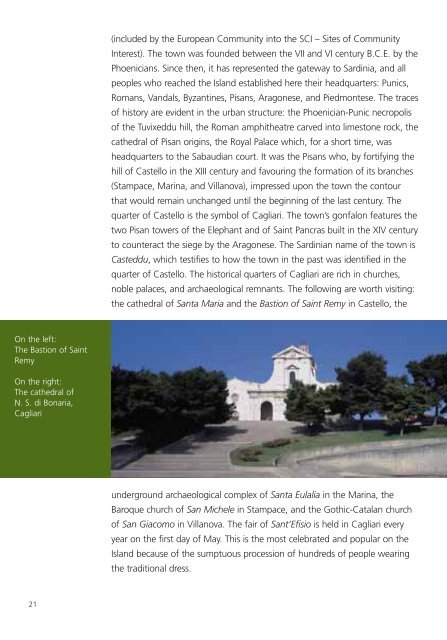You also want an ePaper? Increase the reach of your titles
YUMPU automatically turns print PDFs into web optimized ePapers that Google loves.
(included by the European Community into the SCI – Sites of Community<br />
Interest). The town was founded between the VII and VI century B.C.E. by the<br />
Phoenicians. Since then, it has represented the gateway to Sardinia, and all<br />
peoples who reached the Island established here their headquarters: Punics,<br />
Romans, Vandals, Byzantines, Pisans, Aragonese, and Piedmontese. The traces<br />
of history are evident in the urban structure: the Phoenician-Punic necropolis<br />
of the Tuvixeddu hill, the Roman amphitheatre carved into limestone rock, the<br />
cathedral of Pisan origins, the Royal Palace which, for a short time, was<br />
headquarters to the Sabaudian court. It was the Pisans who, by fortifying the<br />
hill of Castello in the XIII century and favouring the formation of its branches<br />
(Stampace, Marina, and Villanova), impressed upon the town the contour<br />
that would remain unchanged until the beginning of the last century. The<br />
quarter of Castello is the symbol of Cagliari. The town’s gonfalon features the<br />
two Pisan towers of the Elephant and of Saint Pancras built in the XIV century<br />
to counteract the siege by the Aragonese. The Sardinian name of the town is<br />
Casteddu, which testifies to how the town in the past was identified in the<br />
quarter of Castello. The historical quarters of Cagliari are rich in churches,<br />
noble palaces, and archaeological remnants. The following are worth visiting:<br />
the cathedral of Santa Maria and the Bastion of Saint Remy in Castello, the<br />
On the left:<br />
The Bastion of Saint<br />
Remy<br />
On the right:<br />
The cathedral of<br />
N. S. di Bonaria,<br />
Cagliari<br />
underground archaeological complex of Santa Eulalia in the Marina, the<br />
Baroque church of San Michele in Stampace, and the Gothic-Catalan church<br />
of San Giacomo in Villanova. The fair of Sant’Efisio is held in Cagliari every<br />
year on the first day of May. This is the most celebrated and popular on the<br />
Island because of the sumptuous procession of hundreds of people wearing<br />
the traditional dress.<br />
21
















